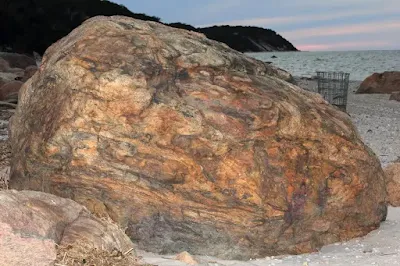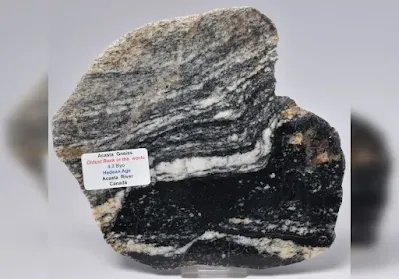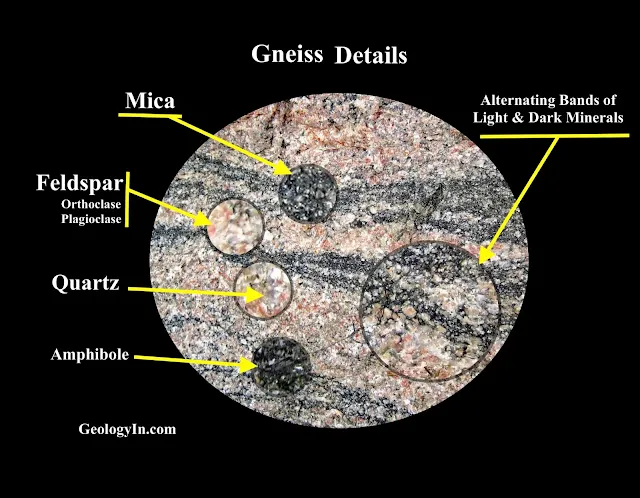Gneiss: Formation, Types, Composition, Uses
Gneiss is a foliated metamorphic rock that is characterized by its banded appearance. The bands are composed of different minerals, which are aligned in parallel layers. Gneiss is formed by the high-temperature and high-pressure metamorphism of igneous or sedimentary rocks.
Gneiss
Gneiss pronounced "nais," (/naɪs/ NICE) is a high-grade metamorphic rock characterized by its gneissic banding and coarse-grained texture. Its genesis is attributed to intense regional metamorphism, where pre-existing igneous or sedimentary rocks are subjected to elevated pressures (>2 kbar) and high temperatures (>600°C).
The metamorphism causes the original rock to recrystallize, and the new minerals form in bands that are parallel to the direction of stress. Gneiss is typically formed at high temperatures and pressures, and it is often found in regions that have experienced tectonic activity.
The word "gneiss" comes from the Old German word "gneist," which means "sparkling" or "bright."
Gneiss's key features:
- Texture: Banded or striped due to aligned minerals; coarse or fine grained.
- Composition: Variable mix of quartz, feldspar, mica, and others; depends on parent rock.
- Color: Wide range; grey, white, pink, black, green, brown, often banded.
- Metamorphism: High-grade heat & pressure from tectonic events; recrystallizes minerals.
- Hardness: Gneiss is generally hard (Mohs hardness can range from 5 to 7).
.jpeg) |
| Gneiss from the Precambrian of eastern USA. |
Composition of Gneiss
The composition of gneiss can vary widely depending on the original rock it was formed from and the intensity of the metamorphic process it underwent.
There are some general trends and common minerals you can expect to find:
Main minerals:
- Feldspars: These are the dominant minerals in most gneisses, typically including potassium feldspar (orthoclase) and sodium feldspar (albite). They give gneiss its light-colored appearance and contribute to its hardness.
- Quartz: This mineral is also very common in gneiss, often occurring as clear, glassy grains. It adds to the overall hardness of the rock.
- Mica: Both muscovite (white mica) and biotite (black mica) can be found in gneiss, contributing to its banding and foliation. Biotite gives the rock a darker color.
- Amphibole: This group of minerals, including hornblende, is commonly found in gneiss formed from igneous or sedimentary rocks rich in magnesium and iron. They contribute to darker bands and add to the rock's overall strength.
Other minerals:
- Pyroxene: Less common than amphibole, pyroxene minerals like augite can also be present in gneiss, especially those formed from mafic rocks.
- Garnet: This mineral can occur as large crystals in some gneiss, particularly those formed under high temperatures and pressures. It adds to the visual appeal of the rock.
Accessory minerals: Trace amounts of many other minerals can be present in gneiss, depending on the specific location and geological history. These might include zircon, apatite, magnetite, and more.
Formation of Gneiss
Gneiss is formed by the process of metamorphism. Metamorphism is the transformation of rocks under high temperatures and pressures. When rocks are subjected to these conditions, the minerals in the rock recrystallize and form new minerals. The new minerals are typically larger and more ordered than the original minerals.
1. Protoliths and Metamorphism:
- Gneiss forms from pre-existing rocks called protoliths. These can be igneous rocks like granites or sedimentary rocks like shales and sandstones.
- During metamorphism, the protoliths are subjected to intense heat and pressure, exceeding 300°C and several kilobars, respectively. This triggers a series of mineralogical and textural changes.
2. Mineral Transformations:
Gneiss formation involves the breakdown and recrystallization of minerals in the protolith. Common minerals like quartz, feldspar, and mica undergo various transformations:
- Quartz: Often shows elongation and recrystallization, forming bands.
- Feldspar: May break down into smaller grains or form new minerals like albite or muscovite.
- Mica: Grows as large flakes, contributing to the banded texture and foliation of gneiss.
3. Fluid-Rock Interaction:
Metamorphic fluids like water and carbon dioxide play a crucial role in gneiss formation. These fluids can:
- Dissolve minerals: This facilitates their movement and recrystallization in new locations.
- Introduce new elements: The fluids can bring in elements like potassium and sodium, leading to the formation of new minerals like muscovite.
- Enhance chemical reactions: Fluids accelerate mineral transformations and recrystallization.
4. Deformation and Foliation:
During metamorphism, the protolith often experiences deformation, such as shearing or folding. This deformation aligns the recrystallized minerals, creating the characteristic banded or foliated texture of gneiss.
Types & Classification of Gneiss
There are many different types of gneiss, depending on the composition of the original rock and the conditions of metamorphism.
The types of gneiss can be categorized based on various factors, including:
1. Classification by Mineral Composition
Granitic Gneiss: This type is rich in quartz and feldspar, giving it a light-colored appearance similar to granite.
Micaceous Gneiss: Characterized by a high concentration of mica minerals like biotite or muscovite, resulting in a sparkly or flaky texture.
Amphibolitic Gneiss: Contains abundant amphibole minerals like hornblende, giving it a greenish or black color.
 |
Gneiss types: micaceous, amphibolitic, and augen gneiss, classified by mineral composition and foliation texture. |
2. Classification by Origin
Orthogneiss
- Formed from the metamorphism of igneous rocks, like granite or diorite. These gneisses often retain some of the original igneous textures, such as large crystals (phenocrysts).
- Rich in quartz and feldspar, leading to a light-colored appearance. May also contain micas, amphiboles, and other minerals depending on the original igneous rock.
- Can be banded or homogeneous, with variations in grain size. Some orthogneisses exhibit augen texture, featuring large, oval-shaped feldspar crystals.
- Examples: Augen gneiss, granitic gneiss, tonalitic gneiss.
Paragneiss
- Originates from the metamorphism of sedimentary rocks, like shale or sandstone. They typically have finer-grained minerals and may show remnants of sedimentary layering, like bedding planes, disrupted by the metamorphic process.
- More diverse than orthogneiss, containing a wider variety of minerals like quartz, feldspar, micas, clay minerals, and garnet. May also exhibit schistose texture with well-developed foliation.
- Typically banded with alternating light and dark layers reflecting the original sedimentary layers. Can also be homogeneous or augen-textured.
- Examples: Micaceous gneiss, pelitic gneiss, garnetiferous gneiss.
 |
| Paragneiss: garnet-cordierite gneiss from Sörmland, Sweden. |
3. Classification by Texture
Banded Gneiss
The banding in gneiss is caused by the segregation of different minerals during metamorphism. The minerals in gneiss tend to have different densities and melting points. As the rock is heated, the denser minerals sink to the bottom of the rock, while the less dense minerals float to the top. This process of segregation leads to the formation of bands of different minerals.
This is the most common type of gneiss, characterized by distinct alternating light and dark bands.
The bands reflect the varying mineral composition, with light bands typically richer in quartz and feldspar, while dark bands contain more mafic minerals like amphibole or biotite.
Banded gneiss can be further classified based on the thickness and regularity of the bands, ranging from fine-grained and tightly folded to coarse-grained and more widely spaced.
Homogeneous Gneiss
Unlike its banded counterpart, homogeneous gneiss lacks visible layering, presenting a more uniform appearance in color and texture.
This uniformity can result from intense metamorphism that obliterates the original banding or from the composition of the parent rock, which may have been relatively homogeneous to begin with.
Homogeneous gneiss can still exhibit a foliation, a subtle alignment of mineral grains that hints at the rock's metamorphic history.
Augen Gneiss
This type of gneiss is defined by the presence of large, oval-shaped crystals (augen) of feldspar, often arranged within the foliation. These augen were originally large crystals in the parent rock, which were stretched and flattened during metamorphism.
Augen gneiss can be visually striking, with the feldspar augen contrasting with the darker matrix of the rock.
Migmatite
This intriguing type of gneiss showcases the ongoing process of metamorphism. It features a mixture of gneiss with patches of granitic material, often forming swirling or intermingled patterns.
During metamorphism, some parts of the rock may partially melt, leading to the formation of granitic material that infiltrates and mingles with the remaining gneiss.
Migmatite provides valuable insights into the complex processes of rock transformation and the formation of new rock types.
 |
| Gneiss outcrop. |
Properties of Gneiss
Foliation is the parallel alignment of platy or elongate minerals in a rock. Foliation is often caused by the realignment of minerals during metamorphism.
Banded: This is the most recognizable feature of gneiss. Minerals segregate into alternating layers during metamorphism, creating light and dark, thick and thin, or even folded and contorted bands.
Coarse-grained: Unlike some other metamorphic rocks, gneiss typically has large mineral grains visible to the naked eye.
Color: Variable, The color of gneiss depends on its mineral composition. Feldspar-rich gneiss is light-colored, while biotite mica-rich gneiss is dark-colored. Patterns and streaks arise from the banding of different colored minerals.
Density: The density of gneiss ranges from 2.6 to 3.2 g/cm³, depending on its mineral composition. This makes it a relatively heavy rock, contributing to its strength and durability. For comparison, granite, another common igneous rock, has a density of around 2.7 g/cm³.
Electrical conductivity: Gneiss is generally a poor conductor of electricity.
Hardness: Gneiss is generally hard due to its tightly interlocked mineral grains and high quartz content. Mohs hardness can range from 5 to 7 depending on the specific mineral composition.
Weathering Resistance: Gneiss exhibits excellent weathering resistance due to its tightly interlocked crystalline structure and presence of hard minerals like quartz. It can withstand harsh environmental conditions, including wind, rain, and temperature fluctuations, making it a suitable choice for outdoor applications like building materials and landscaping features.
Occurrence of Gneiss
Gneiss is a common rock, and it is found all over the world. Some of the most famous gneiss formations include the Adirondacks in New York, the Black Canyon of the Gunnison in Colorado, and the Canadian Shield.
Gneiss is not confined to specific regions but is found on almost every continent. Some prominent areas include:
Cores of Mountain Ranges
Gneiss frequently forms the core of mountain ranges, especially those born from continental collisions. The immense pressure and heat generated during such events trigger the transformation of pre-existing rocks into gneiss. Classic examples include:
- The Canadian Shield: This ancient geological formation in North America exposes vast stretches of gneiss, some dating back billions of years.
- The Himalayas: Gneiss forms the core of the world's tallest mountain range, offering a glimpse into the deep crustal structures.
Precambrian Terranes
Precambrian terranes, remnants of Earth's early continents, are treasure troves of gneiss. These ancient rocks, often over a billion years old, bear witness to the planet's early geological history.
- The Western Ghats of India: This mountain range hosts a diversity of gneissic rocks, offering insights into the formation and evolution of the Indian subcontinent.
- The Pilbara Craton in Australia: This ancient landmass boasts some of the oldest gneisses on Earth, providing clues about the early processes that shaped our planet.
Metamorphic Belts
Wherever regional metamorphism has been at play, gneiss formation is likely. These belts, often associated with past tectonic activity, showcase the transformative power of heat and pressure.
- The Appalachian Mountains: Gneissic rocks are prominent along the Appalachian chain, a testament to the ancient collision that formed these mountains.
- The Alps: Gneiss forms a significant part of the Alpine massifs, a result of the ongoing collision between the African and Eurasian plates.
Unique Geological Formations
Beyond these typical settings, gneiss can also be found in fascinating geological formations:
- Gneiss Domes: These dome-shaped structures result from deep crustal uplifts, exposing ancient gneissic rocks to the surface. The iconic Schoonert Granite Dome in New Hampshire is a prime example.
- Migmatites: These rocks represent a transitional stage between gneiss and granite, where molten rock infiltrates and blends with gneiss, creating a mesmerizing mix of textures and colors.
 |
| Chevron folds in gneiss (Precambrian; Medicine Bow Mountains, Wyoming, USA) Photo: James St. John |
Specific examples:
- The Acasta Gneiss in Canada is one of the oldest intact crustal fragments on Earth, dating back 3.58 to 4.03 billion years.
- The Lewisian Gneiss in Scotland, formed over 2.5 billion years ago, represents the foundation of the Outer Hebrides islands.
- The banded gneiss formations of Rio de Janeiro, Brazil, offer stunning visual displays of this rock type.
Uses of Gneiss
Gneiss is a strong and durable rock, and it is used in a variety of applications. Some of the uses of gneiss include:
Construction:
Building stone: Gneiss with attractive textures and colors finds its way into building facades, cladding, and decorative elements. Its durability and resistance to weathering make it a suitable choice for both interior and exterior applications.
Dimension stone: Certain types of gneiss can be cut and shaped into slabs and blocks for countertops, flooring, window sills, and other architectural features. Its strength and aesthetic appeal make it a popular alternative to traditional materials like granite and marble.
Aggregate: Crushed gneiss forms a crucial component of asphalt pavements, concrete mixes, and construction fill. Its angular shape and strong bonding properties contribute to the overall strength and stability of these materials.
Landscaping:
Flagstones and pavers: Gneiss slabs can be cut into flagstones and pavers for walkways, patios, and garden features. Its natural beauty and slip-resistant surface make it a popular choice for outdoor landscaping.
Retaining walls: Gneiss blocks can be used to construct sturdy and aesthetically pleasing retaining walls for terraces and other landscaping elements. Its strength and stability help it withstand soil pressure and erosion.
Decorative rock: Crushed and polished gneiss can be used as decorative gravel or landscaping mulch, adding a natural and textured element to gardens and walkways.
Other Uses:
Jewelry: Some rare and colorful varieties of gneiss can be polished and faceted into cabochons or beads for jewelry making.
Historical monuments: Gneiss has been used in the construction of historical structures and monuments throughout the world, due to its durability and availability.
Abrasives: Crushed gneiss can be used as an abrasive material in industrial applications like polishing and sandblasting.
 |
| A gneiss rock, oldest-known rock on Earth |
Additional Information
- Gneiss is a high-grade metamorphic rock, which means that it has been subjected to high temperatures and pressures.
- The banding in gneiss can be caused by the segregation of different minerals, by the alignment of mineral grains, or by a combination of both.
- Gneiss is a strong and durable rock, and it is used in a variety of applications, including building, road construction, and decorative tile manufacturing.
Finally, Gneiss is a fascinating rock that is formed by the process of metamorphism. Gneiss is a common rock, and it is found all over the world. Gneiss is used in a variety of applications, and it is a valuable resource.



%20(1).webp)





